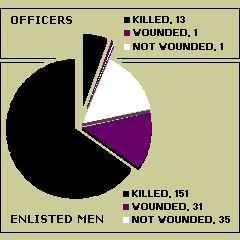
Barton departed New York 23 August, escorting Washington (BB 56) with Nicholas and Meade, transited the Panama Canal 27 August and arrived Tongatabu, Tonga Islands, 13 September. Assigned to Task Force 17 with DesRon 2, (Sims-class destroyers Morris, Anderson, Hughes, Mustin and Russell), she screened aircraft carrier Hornet (CV 8) in an aborted raid on on Buin, Faisi and Tonolai in the Shortland Islands, 5 October. She was still part of Hornet’s escort during the Battle of the Santa Cruz Islands, 26 October, when Hornet was lost.
Barton’s casualties at the Battle of Guadalcanal.

Source: Bureau of Personnel casualty report, NARA.
On 29 October, she rescued seventeen survivors of two downed air transport planes near Fabre Island.
On 12 November 1942, Barton helped escort transports into Guadalcanal’s Ironbottom Sound. After midnight, she was 11th in line among five cruisers and seven other destroyers (DesRon 12’s Aaron Ward, Laffey and Monssen plus goldplaters Cushing and Sterett and 2,100-tonners O’Bannon and Fletcher) as Rear Admiral Daniel J. Callaghan’s Task Group 67.4 intercepted a much stronger Japanese force led by battleships Hiei and Kirishima.
In this First Naval Battle of Guadalcanal, Barton launched four torpedoes before backing full to avoid collision. Two torpedoes from an enemy destroyer hit her before she could get under way again—one in her forward fireroom and the other, almost immediately, in her forward engine room.
Barton quickly broke in two and sank with the loss of most of her crew, including LCdr. Fox. Only 42 survivors were later picked up by heavy cruiser Portland (CA 33); others were rescued by Higgins boats from Guadalcanal.
In 1992, an expedition led by Dr. Robert Ballard located Barton’s bow southeast of Savo Island, resting on its port side in more than 2,000 feet of water with both forward 5-inch guns still trained to port. The ship’s stern section was not discovered.
Barton earned four battle stars in her less than two months in the Solomon Islands.
Source: Naval History & Heritage Command including Dictionary of American Naval Fighting Ships.